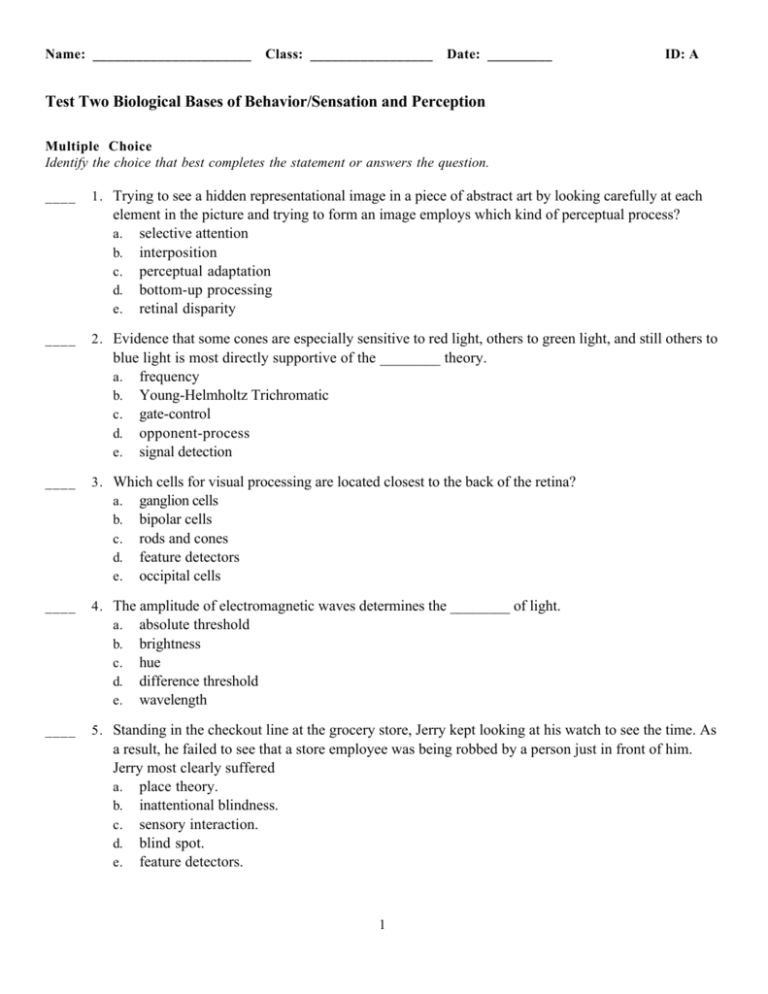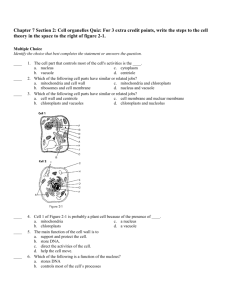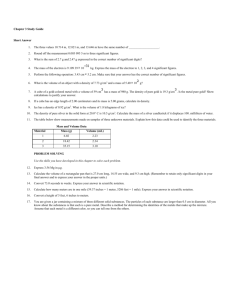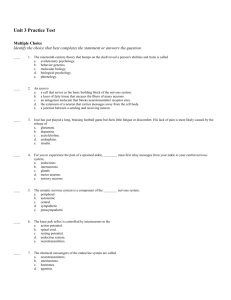Sensation and Perception Test - Rincon History Department
advertisement

Name: ______________________ Class: _________________ Date: _________ ID: A Test Two Biological Bases of Behavior/Sensation and Perception Multiple Choice Identify the choice that best completes the statement or answers the question. ____ 1. Trying to see a hidden representational image in a piece of abstract art by looking carefully at each element in the picture and trying to form an image employs which kind of perceptual process? a. selective attention b. interposition c. perceptual adaptation d. bottom-up processing e. retinal disparity ____ 2. Evidence that some cones are especially sensitive to red light, others to green light, and still others to blue light is most directly supportive of the ________ theory. a. frequency b. Young-Helmholtz Trichromatic c. gate-control d. opponent-process e. signal detection ____ 3. Which cells for visual processing are located closest to the back of the retina? a. ganglion cells b. bipolar cells c. rods and cones d. feature detectors e. occipital cells ____ 4. The amplitude of electromagnetic waves determines the ________ of light. a. absolute threshold b. brightness c. hue d. difference threshold e. wavelength ____ 5. Standing in the checkout line at the grocery store, Jerry kept looking at his watch to see the time. As a result, he failed to see that a store employee was being robbed by a person just in front of him. Jerry most clearly suffered a. place theory. b. inattentional blindness. c. sensory interaction. d. blind spot. e. feature detectors. 1 Name: ______________________ ____ ID: A 6. As the brain receives information about the lines, angles, and edges of objects in the environment, higher-level cells process and interpret the information to consciously recognize objects. This process best illustrates a. sensation. b. bottom-up processing. c. perception. d. selective attention. e. psychophysics. ____ 7. Imagine your friend walking toward you in the hall at school. As your friend gets closer, the image cast on your retina a. gets smaller. b. gets larger. c. gets darker. d. stays exactly the same. e. appears higher in your field of vision. ____ 8. The minimum amount of stimulation a person needs to detect a stimulus 50 percent of the time is called the a. adaptation threshold. b. difference threshold. c. subliminal threshold. d. absolute threshold. e. change threshold. ____ 9. The process by which our sensory systems convert stimulus energies into neural messages is called a. priming. b. sensory adaptation. c. transduction. d. parallel processing. e. sensory interaction. ____ 10. The ability to simultaneously recognize the color, shape, size, and speed of an oncoming automobile best illustrates a. sensory interaction. b. kinesthesis. c. parallel processing. d. subliminal perception. e. blindsight. 2 Name: ______________________ ID: A ____ 11. Which process allows more light to reach the periphery of the retina? a. accommodation of the lens b. transduction of the blind spot c. dilation of the pupil d. sensory adaptation of feature detectors e. focusing light effectively on the fovea ____ 12. Which of the following types of cells are located in the brain's occipital lobe? a. rods and cones b. bipolar cells c. hair cells d. feature detectors e. cochlea cells ____ 13. The local fire department sounds the 12 o'clock whistle. The process by which your ears convert the sound waves from the siren into neural impulses is an example of a. sensory adaptation. b. accommodation. c. parallel processing. d. transduction. e. sensory interaction. ____ 14. Color constancy refers to the fact that a. light waves reflected by an object remain constant despite changes in lighting. b. objects are perceived to be the same color even if the light they reflect changes. c. the perceived color of an object has a constant relation to its brightness. d. the frequency of light waves is directly proportional to the light's wavelength. e. colors remain the same hue even when the tint changes under our difference threshold. ____ 15. Dilation and constriction of the pupil are controlled by the a. optic nerve. b. lens. c. retina. d. iris. e. cornea. ____ 16. Heather Sellers suffers from prosopagnosia and is unable to recognize her own face in a mirror. Her difficulty stems from a deficiency in a. top-down processing. b. transduction. c. kinesthesis. d. sensation. e. accommodation. 3 Name: ______________________ ID: A ____ 17. The organization of two-dimensional retinal images into three-dimensional perceptions is called a. retinal disparity. b. monocular cues. c. perceptual constancy. d. depth perception. e. sensory interaction. ____ 18. The most light-sensitive receptor cells are the a. ganglion cells. b. cones. c. bipolar cells. d. rods. e. iris. ____ 19. When most people stare at a red square and then shift their eyes to a white surface, the afterimage of the square is a. yellow. b. red. c. green. d. blue. e. white. ____ 20. Sensory adaptation helps us to focus our attention on what kind of stimuli? a. familiar b. subliminal c. changing d. intense e. transduced ____ 21. The perceptual tendency to group together stimuli that are near each other is called a. interposition. b. perceptual set. c. proximity. d. closure. e. disparity. ____ 22. Objects are brought into focus on the retina by changes in the curvature and thickness of the a. rods and cones. b. lens. c. bipolar cells. d. optic nerve. e. cornea. 4 Name: ______________________ ID: A ____ 23. Certain stroke victims report seeing nothing when shown a series of sticks, yet they are able to correctly report whether the sticks are vertical or horizontal. This best illustrates a. prosopagnosia. b. serial processing. c. the McGurk effect. d. sensory interaction. e. blindsight. ____ 24. If the just-noticeable difference for a 10-ounce weight is 1 ounce, the just noticeable difference for an 80-ounce weight would be ________ ounce(s). a. 1 b. 2 c. 4 d. 8 e. 10 ____ 25. As your teacher dims the lights to show a movie clip, you still perceive your friend's shirt as red. Which of the following best explains this phenomenon? a. lightness constancy b. perceptual adaptation c. color constancy d. context effects e. perceptual set ____ 26. The ability to pay attention to only one voice at a time is called a. gestalt. b. change blindness. c. frequency. d. the cocktail party effect. e. sensory interaction. ____ 27. Intensity is to brightness as wavelength is to a. accommodation. b. frequency. c. amplitude. d. hue. e. disparity. 5 Name: ______________________ ID: A ____ 28. Which theory emphasizes that personal expectations and motivations influence the level of absolute thresholds? a. signal detection theory b. frequency theory c. opponent-process theory d. place theory e. bottom-up theory ____ 29. A subliminal message is one that is presented a. while an individual is under hypnosis. b. below one's absolute threshold for awareness. c. in a manner that is unconsciously persuasive. d. with very soft background music. e. repetitiously. ____ 30. The light-sensitive inner surface of the eye, containing the rods and cones, is the a. fovea. b. optic nerve. c. cornea. d. retina. e. iris. 6 ID: A Test Two Biological Bases of Behavior/Sensation and Perception Answer Section MULTIPLE CHOICE 1. ANS: TOP: 2. ANS: TOP: 3. ANS: TOP: 4. ANS: TOP: 5. ANS: TOP: 6. ANS: TOP: 7. ANS: TOP: 8. ANS: TOP: 9. ANS: TOP: 10. ANS: TOP: 11. ANS: TOP: 12. ANS: TOP: 13. ANS: TOP: 14. ANS: TOP: 15. ANS: TOP: 16. ANS: TOP: 17. ANS: TOP: 18. ANS: TOP: 19. ANS: TOP: 20. ANS: TOP: 21. ANS: TOP: D PTS: 1 DIF: Medium OBJ: Unit IV | 16-1 Basic Principles of Sensation and perception SKL: Conceptual/Application B PTS: 1 DIF: Medium OBJ: Unit IV | 18-3 Color vision SKL: Factual/Definitional C PTS: 1 DIF: Medium OBJ: Unit IV | 18-1 The eye SKL: Factual/Definitional B PTS: 1 DIF: Medium OBJ: Unit IV | 18-1 The stimulus input: light energy SKL: Factual/Definitional B PTS: 1 DIF: Easy OBJ: Unit IV | 16-2 Selective inattention SKL: Factual/Definitional C PTS: 1 DIF: Easy OBJ: Unit IV | 16-1 Basic Principles of Sensation and perception SKL: Factual/Definitional B PTS: 1 DIF: Easy OBJ: Unit IV | 19-2 Motion perception SKL: Conceptual/Application D PTS: 1 DIF: Easy OBJ: Unit IV | 16-4 Absolute thresholds SKL: Factual/Definitional C PTS: 1 DIF: Easy OBJ: Unit IV | 16-3 Transduction SKL: Factual/Definitional C PTS: 1 DIF: Medium OBJ: Unit IV | 18-2 Parallel processing SKL: Conceptual C PTS: 1 DIF: Difficult OBJ: Unit IV | 18-1 The eye SKL: Factual/Definitional D PTS: 1 DIF: Medium OBJ: Unit IV | 18-2 Feature detection SKL: Factual/Definitional D PTS: 1 DIF: Medium OBJ: Unit IV | 16-3 Transduction SKL: Conceptual/Application B PTS: 1 DIF: Medium OBJ: Unit IV | 19-3 Color and brightness constancy SKL: Factual/Definitional D PTS: 1 DIF: Easy OBJ: Unit IV | 18-1 The eye SKL: Factual/Definitional A PTS: 1 DIF: Difficult OBJ: Unit IV | 16-1 Basic Principles of Sensation and perception SKL: Factual/Definitional D PTS: 1 DIF: Easy OBJ: Unit IV | 19-2 Depth perception SKL: Factual/Definitional D PTS: 1 DIF: Medium OBJ: Unit IV | 18-1 The eye SKL: Factual/Definitional C PTS: 1 DIF: Medium OBJ: Unit IV | 18-3 Color vision SKL: Conceptual C PTS: 1 DIF: Medium OBJ: Unit IV | 16-5 Sensory adaptation SKL: Factual/Definitional C PTS: 1 DIF: Easy OBJ: Unit IV | 19-1 Visual organization SKL: Factual/Definitional 1 ID: A 22. ANS: TOP: 23. ANS: TOP: 24. ANS: TOP: 25. ANS: TOP: 26. ANS: TOP: 27. ANS: TOP: 28. ANS: TOP: 29. ANS: TOP: 30. ANS: TOP: B PTS: 1 DIF: The eye SKL: Factual/Definitional E PTS: 1 DIF: Parallel processing SKL: D PTS: 1 DIF: Difference thresholds SKL: C PTS: 1 DIF: Color and brightness constancy SKL: D PTS: 1 DIF: Selective attention SKL: D PTS: 1 DIF: The stimulus input: light energy SKL: A PTS: 1 DIF: Absolute thresholds SKL: B PTS: 1 DIF: Absolute thresholds SKL: D PTS: 1 DIF: The eye SKL: Factual/Definitional 2 Easy OBJ: Unit IV | 18-1 Medium OBJ: Unit Factual/Definitional Medium OBJ: Unit Conceptual Easy OBJ: Unit Conceptual/Application Easy OBJ: Unit Factual/Definitional Difficult OBJ: Unit Conceptual Medium OBJ: Unit Factual/Definitional Medium OBJ: Unit Factual/Definitional Easy OBJ: Unit IV | 18-2 IV | 16-4 IV | 19-3 IV | 16-2 IV | 18-1 IV | 16-4 IV | 16-4 IV | 18-1








